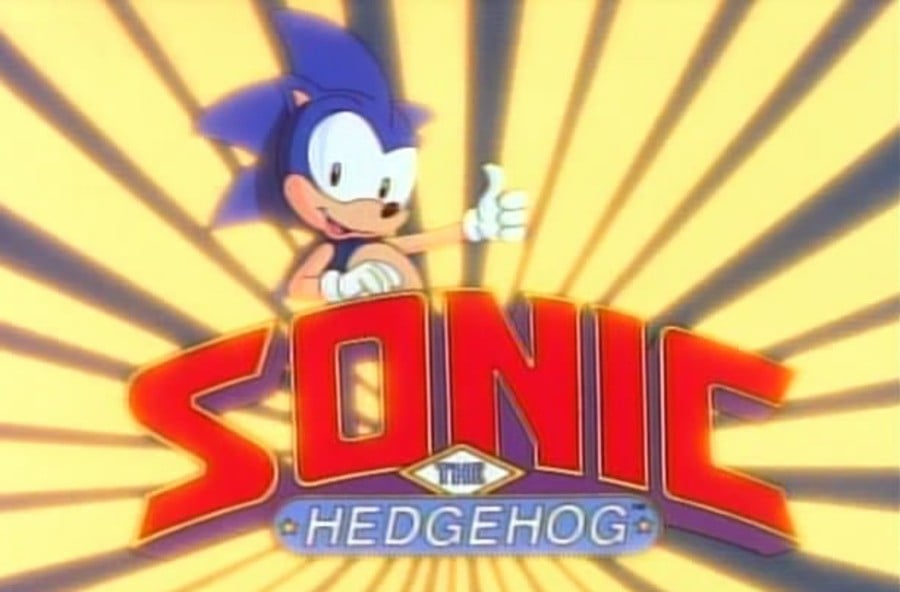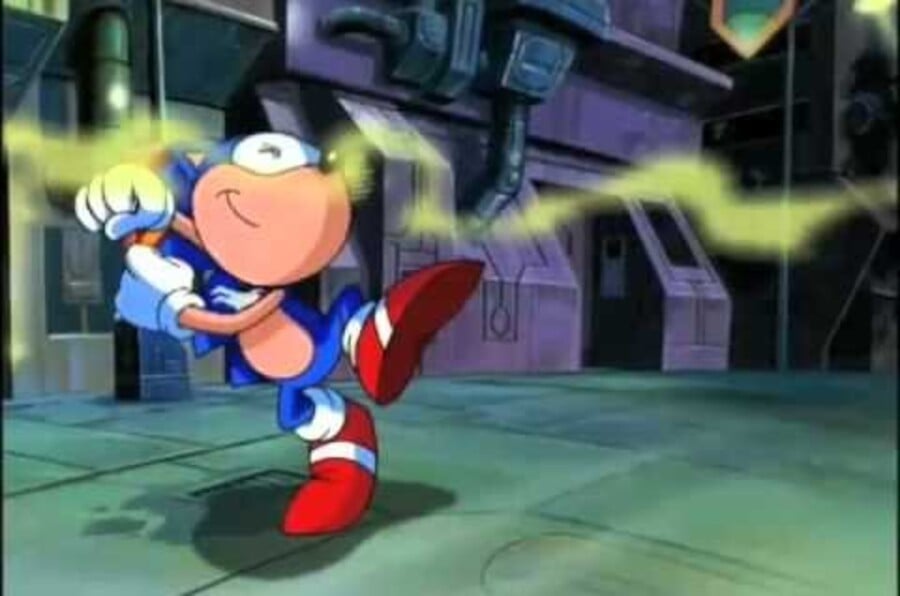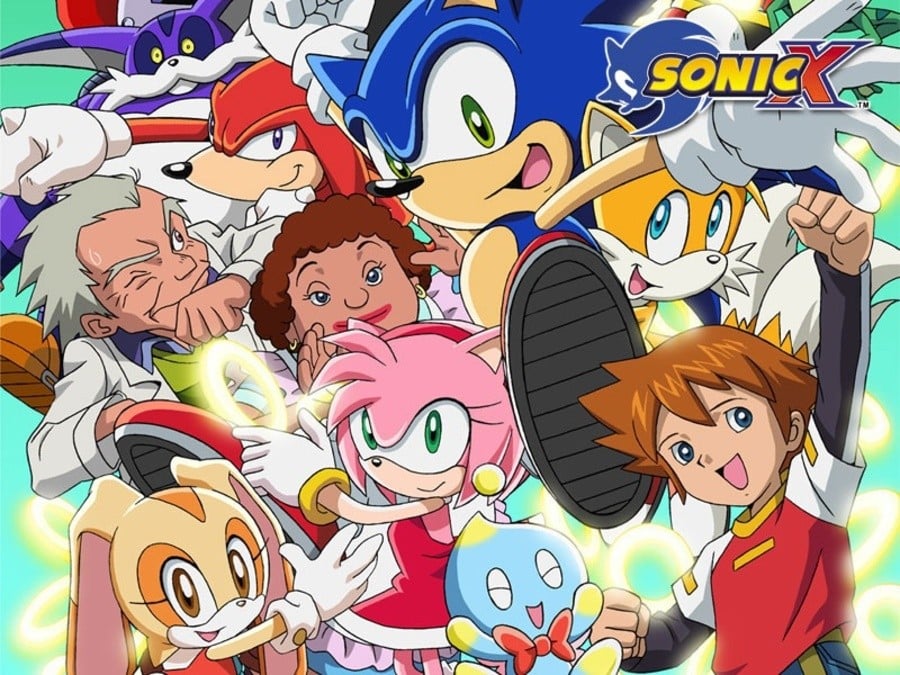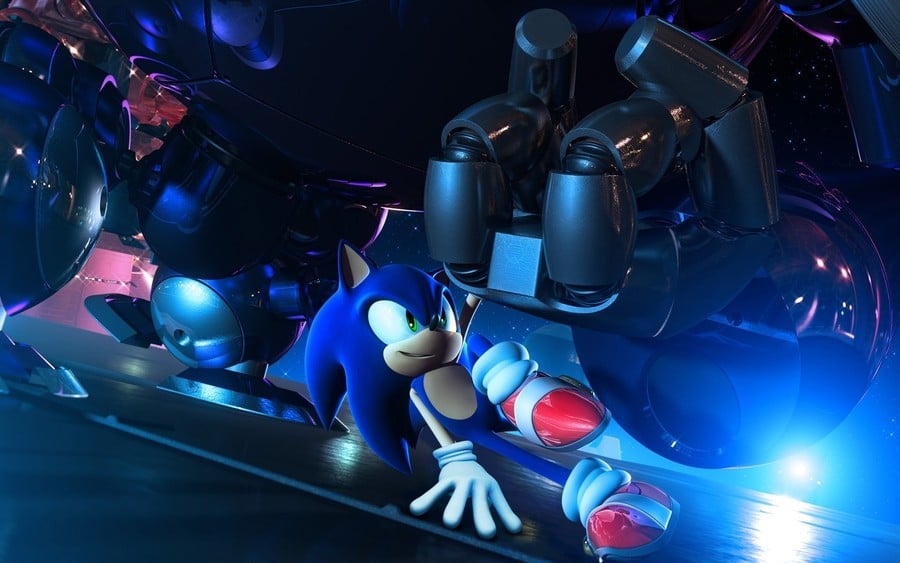For anyone growing up in the early nineties, there was one gaming rivalry that dwarfed all others – Nintendo vs SEGA. While the feud gave us classic moments such as “Genesis does what Nintendon’t” and the infamous Genesis ‘blast processing’, this gaming cold war would split playgrounds and even families over who was the better mascot – Mario or Sonic. It seems strange now considering how well Sonic fits into the Nintendo fold (just look at Smash Bros.), but the nineties were a time where you were either a Sonic or Mario fan; you just couldn’t be both.
The gaming cold war eventually spilled over to television, with Nintendo leading with Captain N at the turn of the decade; the show would play host to everything from Mario to Zelda adaptations (and even Kid Icarus’ Pit alongside Mega Man!), with the Super Mario Bros: Super Show! proving to be an endearing icon of the era, as is Lou Albano’s Mario dance.
But not one to be discouraged, SEGA soon hit back, and in 1993 Sonic the Hedgehog made his first appearance on TV. While Nintendo would ultimately step out of the television battle, SEGA has continued to use animation as a key selling point for the Sonic franchise, and next year we’ll be seeing the blue blur returning to our screens for the first time since 2005, in the aptly named Sonic Boom. While we wait for details on this new project, let’s take a look back at Sonic’s TV history.

Adventures of Sonic the Hedgehog (1993-1996)
What some consider to be the ultimate Sonic the Hedgehog cartoon, Adventures of Sonic the Hedgehog ran between 1993 and 1996, airing 65 episodes over its three year run, along with a final Christmas special where Sonic takes on the role of being Santa. And that basically sums up the show – it’s mad, it’s completely bizarre, but you’ll be hard pressed to find another licensed cartoon that is as funny as this.
Set on the vibrant Planet Mobius, each episode would see Sonic and Tails defeat yet another of Dr Robotnik’s mad-cap schemes – plans such as a Slo-Mo Ray to slow down Sonic or using a Gravity Stopper to lift Sonic off the ground were standard fare for the series. Alongside the main trio of characters were Robotnik’s own “Super Special Sonic Search and Smash Squad”, made up of badniks Scratch, Grounder and Coconuts, characters who have since gone on to become cult favourites.
With its off-beat humour, memorable catchphrases (“I’m waaaaiiiiting” springs instantly to mind) and zany storylines, Adventures of Sonic the Hedgehog proved to be a big hit with the fans. A brilliant supporting cast, including salesman Wes Weasley, kept things fresh, and with Sonic fooling Robotnik using various disguises (even going so far as pretending to be his long-lost girlfriend), laughs were always just around the corner. The show also saw Jaleel White providing the voice for Sonic for the first time, a role for which he would soon become iconic.

Sonic the Hedgehog (1993-1995)
Perhaps the best example of SEGA trying to dominate the market, Sonic the Hedgehog (dubbed Sonic SatAM by fans due to its Saturday morning time slot) appeared on TV screens a mere two weeks after Adventures of Sonic the Hedgehog launched in 1993. Running for just 26 episodes, Sonic SatAM is almost the polar opposite of Adventures, with a much darker and serious tone pervading throughout the show.
Set again on Mobius, Sonic SatAM is based in the city of Mobotropolis, which has been taken over by Dr Robotnik and his nephew Snively. Working with the Freedom Fighters, Sonic (voiced again by Jaleel White) and Tails fight to free Mobotroplis from the SWATbots and thwart Robotnik’s evil schemes. It’s a far darker tone than the random insanity of Adventures, and ultimately it was cancelled prior to its third season. But the legacy left behind is one that no other series has even come close to matching.
The show had a big influence on the trajectory of Sonic the Comic (and vice versa), with Freedom Fighters Princess Sally, Bunnie Rabbot, Rotor and Antoine all playing key roles in both series, along with Snively and the concept of Roboticizing. 18 years after the show’s cancellation, the story of the Freedom Fighters is still alive and well in the comics, and that is a legacy no show can match.

Sonic the Hedgehog: The Movie (1996)
An hour-long “movie”, Sonic the Hedgehog: The Movie is something of a black sheep among the Sonic cartoons. Produced in Japan, it features none of the hallmarks of the previous series, instead introducing its own take on the Sonic universe. With no voice actors from the other series either, it stands out from the rest, yet despite its odd nature, it has a devoted following.
The plot once again sees Sonic and Tails thwarting Dr Robotnik’s evil plans, this time to save the President’s daughter. Along the way they enlist the help of a Stetson wearing Knuckles, and face off against Metal Sonic, which should go some way to explaining why this is such a cult hit. Animated in the same style as the Sonic CD introduction, there’s certainly a lot to enjoy about this unique moment of Sonic history.

Sonic Underground (1999-2000)
It would be three years until Sonic hit TV screens again, this time courtesy of a French animation studio. And it’s safe to say that this isn’t Sonic as you remember him. Once again set on Mobius, Dr Robotnik has overthrown Queen Aleena, who sent her three children into hiding to save them from Robotnik’s forces. Years later, these three siblings discover their true destiny – to defeat Robotnik and return their mother to her rightful throne. The children? None other than Sonic (voiced by Jaleel White for the final time) and his new brother and sister, Manic and Sonia the Hedgehog. And they have magical instruments that when played defeat whatever it is needs to be defeated.
It’s yet another crazy setup for a Sonic cartoon, and the show is supported by even crazier characters – Sleet and the shape-shifting Dingo make up Robotnik’s primary force (and comic relief), while the hedgehogs join forces with the Freedom Fighters to stop Robotnik. Underground would see the return of Knuckles to the cartoon series, along with a Sean Connery sound-a-like for his great-grandfather, Athair.
Sonic Underground is truly unlike any other Sonic cartoon, with episodes interspersed with musical segments where the hedgehogs get out their instruments and play a song, complete with lyrics. The show was met with a modest response, but was ultimately cancelled before Queen Aleena was restored to her throne – since then fans have been campaigning for an ending, and last year a comic adaptation was penned in for the 50th issue of comic Sonic Universe. At the time of writing, there has been no further news on this finale, or why it was not published in issue 50.

Sonic X (2003-2005)
The most recent Sonic cartoon to date, Sonic X took the series to Earth, and created one of the truest representations of the Sonic game canon ever committed to television. One of the key successes of Sonic X was in bringing across the entire roster of Sonic characters to the small screen, with everyone from Big the Cat to Team Chaotix given screen time, and more importantly bringing across their voice actors from the games.
After a Chaos Control incident transports the gang to Earth, Sonic meets up with Chris Thorndyke, a random kid who takes them in while they work on finding the Chaos Emeralds before Dr Eggman (note the name change). The show has a very different feel and tone to its 90s counterparts, largely due to a different approach to cartoon creation, but still features many of the series’ cartoon tropes. Eggman is accompanied by robots Decoe and Bocoe, who effectively replace Scratch and Grounder, while Sonic and the gang are supported by the Thorndyke family (who proved controversial with fans).
Where Sonic X truly succeeded was in its retelling of iconic stories – the Perfect Chaos arc from Sonic Adventure and the Shadow Saga from Sonic Adventure 2 were key elements of the end of the first season, with character development expanded upon from the original source material. It was also a surprisingly touching show, with Sonic and Amy’s relationship developing over the series, but it also had a lot of comedy, with Team Chaotix proving to be worthy punchlines. The show ultimately gained a second season which saw a more Star Trek approach taken in the Meterex saga, before ending with an emotional finale. Since then, there have been almost yearly rumours of a third season, but it does seem now that Sonic X is consigned to the history books.

Sonic Boom (TBC) (2014- )
And that’s because starting late next year, Sonic will be back in the tentatively titled Sonic Boom. With an initial production order of 52 11-minute episodes, Sonic Boom is being penned as a comedic take on the Sonic universe, perhaps not too dissimilar to Adventures of Sonic the Hedgehog. With the voice cast from the games mostly on board, it is sounding like a promising project, and one that will hopefully be a worthy continuation of the legacy left behind by the previous four series.
Whatever the reaction to Sonic Boom ultimately is, it seems that once again Sonic has become a brand that SEGA is promoting in as many ways as possible. With the games series also making regular appearances, this year’s Sonic Lost World being the latest, it stands to reason that the Sonic franchise is heading in a positive direction once again. And a new cartoon series can only add to that.
What are your memories of the Sonic cartoons? Are you looking forward to watching Sonic Boom next year? Let us know in the comments below.





Comments 46
Good article! Huge fan of Sonic and these shows — as it was a huge part of my childhood and now my children's to watch these. Sonic FTW!
I think i owned a video of one of these cartoons when i was a very young child. The only episode i remember if i remember it correctly was sonic wearing a dress and appearing in front of (might have been) Dr. Robotnik.
It's a shame that many cartoons, especially based on video games don't last long, there was even an anime based on Virtua Fighter.
@DestinyMan I was the same way. Me and my friends were both Mario and Sonic fans growing up in the early 90's. oh the Super Nintendo and SEGA Genesis day's where truly magical.
They really should just scrap Cubot and Orbot, and bring back Scratch and Grounder.
The '96 movie was pretty cool - the characters interacted like you'd think they would if you played Sonic CD heavily. And that's a really unique and cool universe, with many planets and wide gaps between lands. Great stuff.
I've seen all of these bar Underground (and Boom of course). Adventures was so off-the-wall and looney that I couldn't help but laugh. SatAM had a nice mix of humor and action, which I enjoyed (Sonic's characterization in both of those was priceless). The OVA was cool, especially the Metal Sonic fights and Robotnik's look. Sonic X was mixed. It was cool to see adaptations of Adventures 1 and 2 (plus Chaotix), but the increasingly sloppy animation, out of character moments, and the shoehorning of Chris were disappointing. I can't wait to see what Boom brings to the table.
The short cutscenes in Rondo of Blood are the only video game related cartoon bits I have ever been interested in. (They blew me away). That would have been great as a cartoon.
In the 90s, i was a huge fan of BOTH Mario and Sonic. I pitied kids who limited themselves by only playing one system. I was fortunate enough to have both SNES and Genesis. I watched both Sonic cartoons, and loved them. I've always thought Sonic was a cooler character than Mario, but that Mario's games are better (back then it was true, but today its even moreso). I have owned (and still own) all of Ninty and Sega's consoles except for the Virtual Boy from Ninty and the Saturn from Sega. When Dreamcast failed, i really wanted Ninty to buy Sega, and i still do, so that all my favorite franchises from my childhood would be on one console.
The Adventures of Sonic the Hedgehog and the Sonic movie have always been my favorites.
I used to love AOSTH. Brilliantly done, offbeat, madcap fun. Never saw any of the others - I do like the vibrant, crisp anime art style of Sonic X though.
The following quote is mandatory when discussing Sonic cartoons:
Robotnik: "snooping as usual, I see!"
When I was a kid there were two Sonic shows: the cruddy one for kids, and the super awesome one where the world has been taken over and everyone is turned into robots and everything is super awesome and cool.
I wish they'd make another really cool Sonic cartoon, but after Sonic Adventure they seem bent on mixing humans into the world, which makes it really lame in my opinion.
@GeminiSaint I managed to sneak that into a tweet earlier this week
@HyperSonicEXE As much as I love Cubot and Orbot, bringing back Scratch and Grounder would be the greatest thing ever!
Adventures Of Sonic The Hedgehog is the greatest and this is why!
@GeminiSaint Quite!
@Sonicfan11589 Pokemon?
Good stuff, but the Earthworm Jim cartoon was better.
While I enjoyed "Adentures of Sonic the Hedgehog," I think "Sonic the Hedgehog" (Sonic SatAM) is the true jewel of Sonic cartoons (never saw "Sonic Underground"). It was brilliant in the way it mixed the usual Sonic cheesiness with an epic, serious storyline that didn't go overboard in abusing the laws of physics.
Although, I've always preferred more serious cartoons with continuity and more realistic physics over random wackiness like Looney Tunes, even as a kid, and I'm also a sucker for "fledgling righteous rebellion against an powerful evil conquering force" plots (which explains why I liked the short-lived series "The Cape"), so maybe I'm just a small minority here.
I think I've seen Sonic Underground,but I'm thinking of going to see Sonic Boom next year.
I've seen all of these except for Sonic Underground (and Sonic Boom obviously)
I personally don't have a lot of childhood memories in regards to Sonic the Hedgehog animations. In fact, for the most part, I managed to watch all these shows in the later years, so they don't have a lot of meaning to me as other people. I was a much more avid follower of Archie Comics' series than the animations, and I still collect the comics to this very day!
With that said, doesn't the animated short based on Sonic Unleashed count? Doesn't anybody here remember the silly shenanigans of Night of the Werehog? It should fit the bill, as this is October, and Halloween is coming up!
I like the idea of Sonic boom, but CGI is WAY overused in the entertainment industry, i think my idea for Nintendo and maybe sega is to Contact Madhouse/Shaft/4oC/Bones/Aniplex Or any other Anime makers and the voices from the Games or the best of FUNimation. Then make a crossover Nintendo Handrawn Anime with Console and VG references and Maybe even some Memes.
''and it is GLORIOUS''
-That guy in that MK movie
@HopeNForever My original draft did include that (I love it personally), but wanted to focus more on TV series (and the movie almost got cut too)
Can't remember much of Sonic's older cartoons (blame Mario's, lol), remember X's though...it was ok. I like Sonic's attitude. xD
I was definitely a fan of both mascots as I had/have a Sega Genesis and Super NES. I did lean more towards my SNES than the Genesis.
Anyway, I loved the old Sonic Cartoons back in the early to mid 90's. I was in 6th grade when Sonic first aired on tv after school. I raced home to catch every episode. LOL Ahh nostalgia!
I'm a huge Sonic X fan. Sonic, Knuckles, Tails, Amy( best! ), and more made it an amazing show. The second season was the best. My brothers and I ALL watched this show every Saturday morning... Even my oldest brother, who was then 21. XD Of course in the beginning I didn't know what was going on haha. After a few years though I'd be shouting 'Hey it's the ghost episode!' in which Amy gets demon possessed. I loved it, still do. What a great series, I need to watch it again. It was a perfect blend of action, realism( well, realism when you're six), and emotion. Chris's friendship with Sonic, the Sonic and Knuckles Rivalry, Sonic and Amy, government agents, the President, Chris's wacky butler and in the finale, where it acknowledges time really does speed by, just like Sonic.
It's still in syndication...
Despite the blow this morning to discover Sonic Lost World won't be as good as I hoped, NintendoLife has been SEGALife to me in the past few days. So many hedgehog related articles.
I think the new Sonic cartoon would be awesome if it was set on where Sonic lives like Mobius and with cameo appearances from lots of characters like Silver, Blaze, Metal Sonic, Shadow, and the Chaotix etc.
Reading this article has made me think back to all the games that were turned into cartoons. Legend of Zelda, Donkey Kong Country, Rayman, Earthworm Jim. Even Mortal Kombat got it's own cartoon! If a game was popular enough, you could pretty much guarantee it would get a TV series.
If there's one game I'd love to see a TV series of, it'd have to be Phoenix Wright. I'm really surprised there hasn't been an anime series of it. Who knows, maybe one day...
I remember watching all of these growing up.
Oh, the memories...
@HopeNForever
I remember that, haha.
sonic x didnt have the voice actors from the games.. the show came out and sega fired all the old ones and started using the awful sonic x cast it completely ruined the show for me and then the games afterward seriously..
Why is everyone trying to do comedy on TV these days.
Reason why Cartoon Network failing.
Back on topic. I wish the Sonic X gets a 3rd season. Yeah its not as good as the other ones, but it was tolerable at least
Ahh I remember coming home from school and watching all of those back in the day!!! I grew up with all of that. Sonic will always be one of my favorite gaming/cartoon characters. It sucks he's headed down green hill these days tho.
When I was younger, me and my brothers would always watch Sonic X. Still my favourite childhood show.
"I'm waiting" is the most memorable quote, for me as well.
Ha! I remember a sonic fan to hit me by saying the teacher let my table leave the room first because Mario was better. Man they don't make rivalries like that anymore! Or cartoons for that matter.
@HopeNForever I've never seen that before, it was really good and I adore Polaroid cameras so that made it even better for me!
I loved "The Adventures Of" - I watched every episode and stubbornly refused to watch the other series because of it. I didn't realise there was a movie tho! I'll give that a try, anyone know if it's any good? Love Knuckles' hat btw
I got to watch some of "Sonic The Hedgehog" growing up, so even a kid that lived more in the 2000's first decade than in the 90's got to experience it. Good stuff, haha!
Cool. Hope it doesn't disappoint!
One of the confirmed writers of Sonic Boom, Dave Polsky, is a writer for My Little Pony: Friendship is Magic.. Call me excited!!
AOSTH is definitely the best Sonic cartoon ever made. I love Sonic SatAM mainly because Robotnik is super evil in this one, and after that it seems the the Sonic cartoons get worse and worse, hopefully Sonic Boom won't disappoint.
Sonic was SO MUCH BETTER THAN THE SMB SUPER SHOW! I enjoyed it so much more! Mario really isn't made for some media types.
Adventures of Sonic the Hedgehog was awesome and I loved following it. It brings memories of playing the classic games.
Sonic Underground was awesome! The plot was epic and a blast to follow! I loved the story too!
Sonic X is OBVIOUSLY THE BEST ONE! I know it's modern but it's just so cool. Modern Sonic is the best absolutely. This has a storyline that makes a load of sense, pretty much every character that we wanted was included, like Emerl. Loved him in Sonic Battle, gets a great place in Sonic X. I watched the SMBSS, and it was enjoyable, but it was so SHORT! I blew through every episode in 3, 4 or 5 days. Sonic never ceases to entertain me, I guess.
Sonic's current voice actor sucks in my opinion, I can't get that cool feel from Sonic since it changed in Colors. I'm still hoping it was the lines and not the voice, but everytime I hear it's voice, I can only think "yuck"...
Sonic's favorite food is Chili Dogs. After seeing that in the cartoon, it became my favorite kind of hot dog.
Now I'm a vegetarian.
I still eat Veggie Chili Dogs. Mmmmm...
OH, and the movie was absolutely AWESOME. LOVED, LOVED, LOVED, it.
I watched a bit of each of them, but only the movie and SatAM held my interest. Though, those two WERE awesome. I don't even like Sonic a ton(just casually following), but I love 'em both.
I think AoSTH gets too much flak sometimes, but I can also see why some people dislike it.
As for Underground and X... Ugh! I just couldn't go past an episode of either. I don't know... I just found Sonic so... annoying in those shows!
Show Comments
Leave A Comment
Hold on there, you need to login to post a comment...